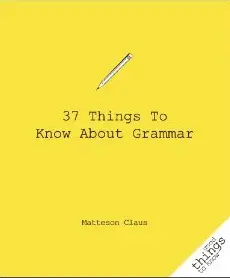 Readers of the grammar section of FWJ know just how tricky grammar rules and application can be. It is no wonder that a lot of people have developed an aversion to grammar. However, we cannot deny the importance of following grammar rules, especially for those who make a living out of writing. Now what if you had a quick reference guide that you can thumb through for the trickiest grammar points?
Readers of the grammar section of FWJ know just how tricky grammar rules and application can be. It is no wonder that a lot of people have developed an aversion to grammar. However, we cannot deny the importance of following grammar rules, especially for those who make a living out of writing. Now what if you had a quick reference guide that you can thumb through for the trickiest grammar points?
That’s exactly what I found in Matteson Claus’s gem of a book, 37 Things to Know About Grammar. Matteson is no stranger to Freelance Writing Jobs, as she has been following us for quite some time now. When she sent an e-mail informing us of her new book, we decided to take it for a spin. What better venue to talk about the book than Grammar Guide?
So what makes 37 Things interesting for writers? As the title implies, it is neatly divided into 37 sections. Each section focuses on a specific grammar point that can be particularly troublesome. Let me give you a few examples.
Does the term “pronoun antecedents” ring a bell? Here’s an excerpt which shows how the book treats this grammar point.
Pronouns are not spies. They should not have secret identities. On the contrary, it should always be clear what noun your pronoun is replacing. A pronoun that loses track of its noun is kind of like a child losing track of its parent. The pronoun gets confused and all sorts of chaos ensues. Unclear pronouns cause misery. Don’t believe me? Say you’re obsessed with dating a supermodel and you get this bit of news:
Yesterday, we interviewed Serena, the serial killer, and Giselle Bundchen, the supermodel, and she said that she thinks you’re hot.
Pronoun antecedents are so basic but can be easily overlooked. In order to get the message across very clearly, we do need to make sure that the nouns and pronouns match and that there is no ambiguity – as is seen in that example. Matteson Claus sums the idea up neatly: “If they are out to get you, it helps to know who “they” are.” Indeed.
Other items included in the book include the use of commas, parentheses, and dashes. You can also read up on the use of who and whom, among other commonly confused words.
To be honest, this book will not serve as a comprehenive grammar guide. In fact, the author will tell you herself that she does not intend her work to serve as such. Instead, she picked out concepts that often cause people trouble and presents them in a light manner. Indeed, the lightness of the presentation may not appeal to hardcore grammarians, but I believe that the treatment will go a long way with those who have an earnest desire to use proper grammar without feeling as if they are being slapped on the wrist. If you have a sense of humor, you will appreciate this book.
To give you more insight on the lightness of the treatment, take a look at some chapter headings.
- Who, that, and which, while pesky, are not worth any nail-biting
- There’s no need to feel bad because you become badly confused trying to do a good job using your adjectives and adverbs well
- OMG r u 4 real? IMHO u must 86 this habit B4U get axed
- Please be gentle with our wee brains separate each of your ideas clearly so our heads don’t explode
I have to say that 37 Things to Know About Grammar can be a handy – albeit limited – reference for those who consider themselves well-versed in the English grammar. To be honest, though, I would not use it as my main guide. I would definitely not hesitate to give out copies of this book to friends, though. I recommend checking it out.
You can buy 37 Things to Know About Grammar from Amazon.
If you want to know more about Matteson Claus, here is a video of her being interviewed on Good Morning Texas.

Leave a Reply